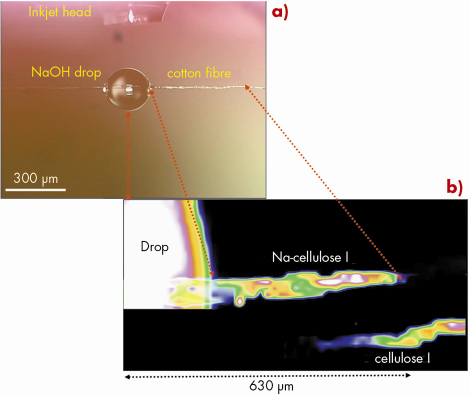- Home
- Users & Science
- Scientific Documentation
- ESRF Highlights
- ESRF Highlights 2007
- Soft Condensed Matter
- Intermediate steps in the mercerisation of a single cotton fibre
Intermediate steps in the mercerisation of a single cotton fibre
The transformation of cellulose I into cellulose II by aqueous NaOH is a commercial process known as “mercerisation”. Mercerised cotton fibres exhibit a more appealing luster, greater tensile strength, and uptake dye more easily than their untreated counterparts. The conversion of cellulose during mercerisation involves at least one (possibly more) intermediate Na-cellulose crystalline phases. The study of these intermediate phases is of particular interest both from an academic and a commercial perspective. Current techniques to study these intermediate phases lack either spatial resolution (X-ray diffraction on fibre bundles) or have to be performed ex situ on ultrathin sections (electron diffraction). In contrast, X-ray microdiffraction at the ID13 beamline provides the possibility of working in situ on single cotton fibres during the conversion process. The cotton fibre was kept under a slight tension during the conversion process and the formation of Na-cellulose was initiated locally by creating a NaOH-drop by using an inkjet system head. The high surface tension of the tiny NaOH-drop, about 300 micrometres diameter, keeps it attached to the cotton fibre (Figure 62a). Aqueous NaOH, diffusing from the drop into the fibre, becomes increasingly concentrated along its diffusion path as the fibre is permeable to water vapour. The extent of Na-cellulose I formation was studied by a mesh-scan along the reaction zone of the fibre with a submicrometre-sized beam. The extent of conversion of cellulose I into the crystalline Na-cellulose I phase could be easily determined from the intensities of the 002 Bragg reflections of both phases (Figure 62b). Future experiments will be performed at higher temperatures and will involve a washing step using a second inkjet system head, which would allow the study of the complete mercerisation process.
 |
|
Fig. 62: a) Optical image of inkjet system head and NaOH-drop on single cotton fibre. b) composite image based on 002 intensities of Na-cellulose I and cellulose I. This allows a localisation of the cellulose I/Na-cellulose I conversion zone along the fibre. The cellulose I phase has been displaced vertically for better visibility. |
Principal publication and authors
J. Schoeck, R.J. Davies, A. Martel, and C. Riekel, Biomacromolecules 8, 602-610 (2007).
ESRF



